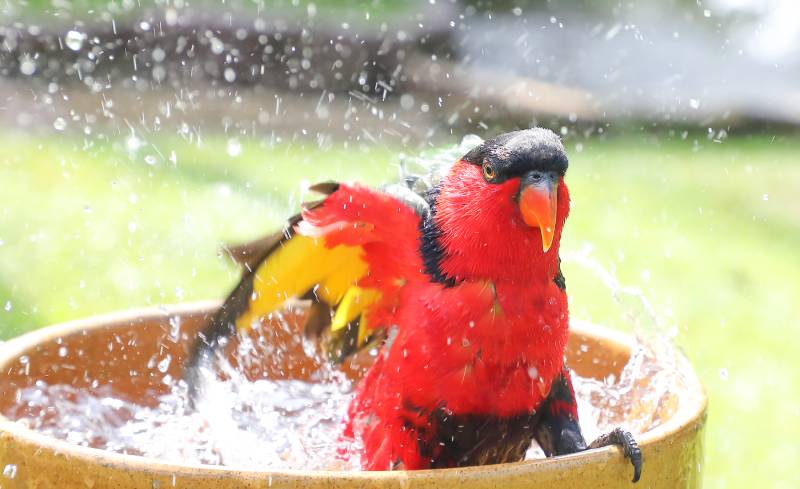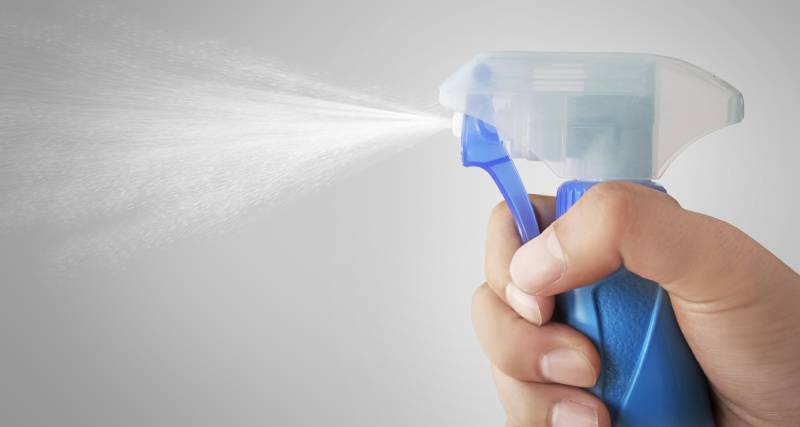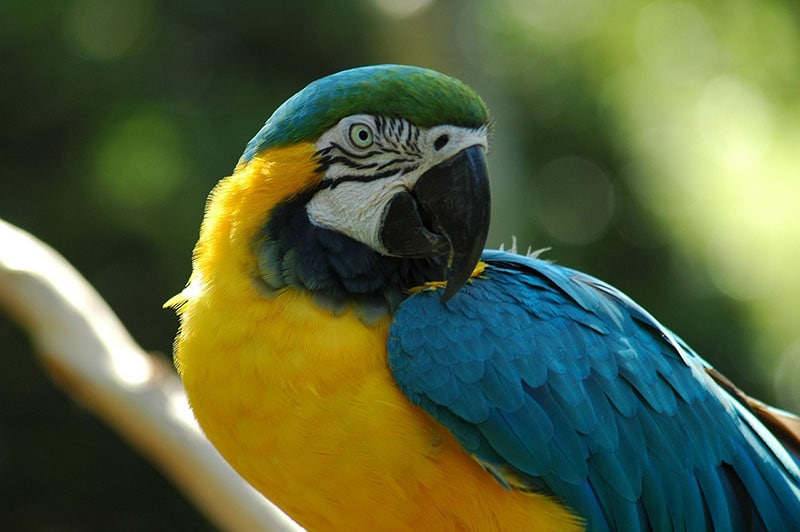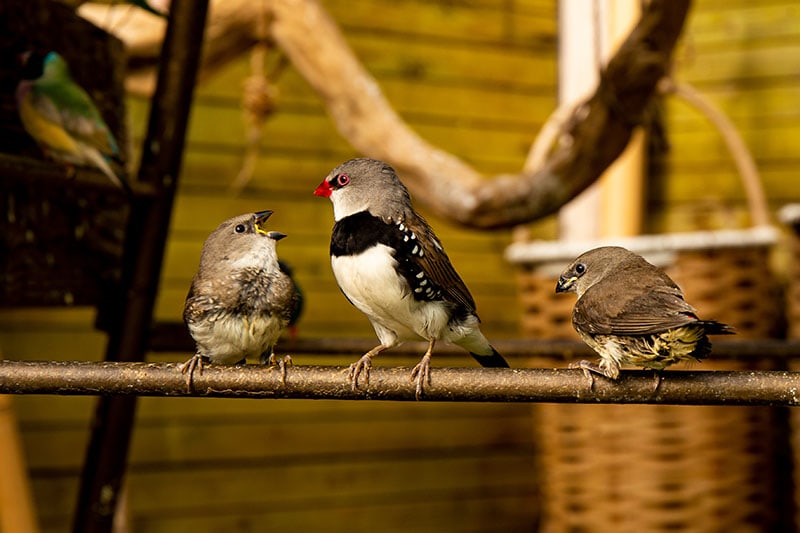How to Bathe a Parakeet: 4 Vet-Approved Tips & Tricks
By Kit Copson
Updated on

Click to Skip Ahead
Bathing an animal is often dreaded even by the most devoted pet parent, but if your companion is a parakeet, we’ve got some good news—birds bathe themselves. All you need to do is provide clean water and maintain the bathing environment.
In this guide, we’ll explain how to encourage your parakeet to take baths and make sure they have a great time while doing so.
Do Birds Need to Have Baths?
Yes, bathing is essential for birds because it keeps their feathers and skin clean and in good condition. For one thing, dirt, dust, debris, and other pollutants can build up on the feathers, and regular bathing washes these away. Additionally, without regular baths, air conditioning and central heating in our homes can dry out the bird’s skin and make it itchy. Bathing helps condition skin and feathers.
Some birds like to take a bath every day, whereas others only do so every few days. Whatever the case, it’s important to offer your parakeet lukewarm water daily to encourage bathing. Only offer a bath during the daytime as you don’t want your parakeet to be wet overnight.
The 4 Tips & Tricks For Bathing Your Parakeet
There are a few ways to provide your bird with bathing water, so let’s explore each method in depth. You do not need to (and should never) use any soap on your parakeet—just lukewarm water is enough.
1. Water Dish/Bird Bath

What You’ll Need:
- Dish/bird bath/sink
- Lukewarm (non-chlorinated) water
- Bird-safe cleaner
- Towel (optional)
If you go for the traditional method, all you need is a receptacle shallow enough for your parakeet to splash about in safely. This can be in the form of a dish or a commercial bathing chamber that you can attach to the enclosure, but these are typically sized for smaller birds (there are different sizes of parakeets, so check carefully before you buy). Bathing chambers are often covered to help keep the water contained.
Alternatively, your parakeet can bathe in a sink if that’s what they prefer. Whatever your chosen receptacle, let your parakeet enter it at their own pace instead of just plopping them in there, especially if they’re not used to it.
Once in, your parakeet will splash about in the water and shake it off. If you’re worried about water splashing everywhere, you can place a towel underneath your parakeet’s enclosure or wherever you’ve put their water dish.
After the bath, your parakeet will dry off by fluffing up their feathers and fluttering to generate airflow. They’ll also preen themselves by arranging their feathers until they’re happy with their positioning. Clean out the dish with a bird-safe solution like a mild dish soap.
2. Spray Bottle

What You’ll Need:
- Clean spray bottle
- Lukewarm (non-chlorinated) water
If your bird isn’t keen on getting in a bath, you can use a spray bottle to gently mist them from above. Many birds love this as it mimics rain. Remember to adjust the nozzle to the mist setting—powerful sprays or streams of water will stress out your bird. Make sure the spray bottle you use doesn’t have any remnants of previous chemicals.
3. Shower

What You’ll Need:
- Shower perch
Some birds love hopping in the shower with you to revel in the steam and gentle water splashes. If your parakeet isn’t used to the bathroom, start by taking them on little bathroom trips and letting them bathe in the sink or a bowl while in there. This will allow your bird to gradually get comfortable with the new environment before they head for a shower.
When you first introduce your parakeet to the shower, keep the water pressure low and let them explore at their own pace. You can buy adhesive bird perches for showers, which should be placed out of the direct water stream.
The goal is for your parakeet to enjoy the light sprays and splashing from the stream of water rather than being directly in it, as this is frightening for them and sometimes even dangerous. It’s also essential that the water isn’t too hot or too cold for your bird.
4. Veggies

What You’ll Need:
- Washed leafy green veggies
Small birds like brushing against and playing with vegetation, which can help clean the bird if the veggies are wet. You can try offering freshly washed leafy green veggies to reluctant bathers or young birds just getting used to the bathing process.
How to Dry a Parakeet
As long as the room is nice and warm, your parakeet will dry off without any help from you. They do this by shaking off the water, fluffing up, and flapping/fluttering a bit to get some air going. Some birds head for a sunny spot in the room to dry off more easily.
Just beware that a chilly or drafty room will make it much harder for your parakeet to dry off and will be very uncomfortable for them. In addition, using blow dryers on birds can be dangerous and is best avoided.
Extra Tips
- If your tap water is chlorinated, use bottled water for bird baths instead.
- More frequent bathing can help birds through the molting period.
- You should never use shampoo, soaps, or chemicals on your parakeet. Lukewarm water will suffice.
- If your parakeet keeps bathing in their drinking water, they may need to be offered more opportunities to bathe. Give them water to bathe in every day even if they don’t use it every day.
- If something is stuck in your parakeet’s feathers, please contact a vet for advice.
Final Thoughts
If you’re a new parakeet parent who was worried about the prospect of bathing them, you’re sure to be relieved now you know birds are great self-bathers. Your job is to ensure they have clean water to bathe in and encourage them if they’re a little iffy about bathing. If you have any other questions related to your bird’s grooming regimen or are concerned about your bird’s skin and feather health, please speak to your vet.
Featured Image Credit: Oqbas, Shutterstock












